United Airlines is growing faster than competitors, it’s making significantly more money than most of its rivals, and ran something of a victory lap in this week’s earnings call even as the economy is weakening and that will have an impact on the airline’s fortunes.
They offered two different guidance scenarios for their financial performance this year, which is highly unusual – one with recession and one without – but they argue that they’ll still make money in recession because they’ve become a “brand-loyal airline.”
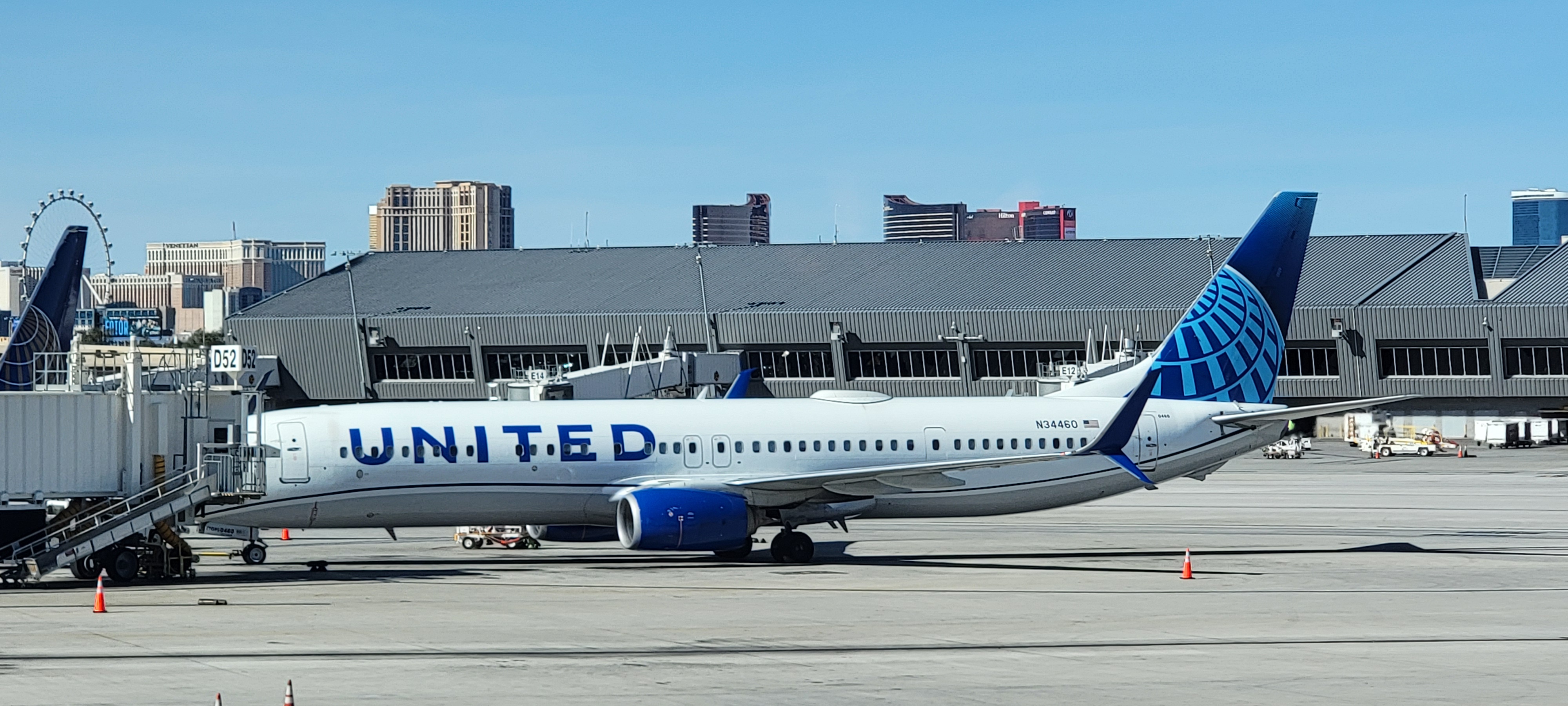
And while ultra-low cost carriers might be expected to outperform as consumers are stretched due to the economy and “trade down” they argue that this isn’t the case – they’ll just drop fares to fill planes, and airlines will cut back on the total amount of flying.
Several slides from the airline’s employee presentation have been making the rounds. These were first posted by aviation watchdog JonNYC.
UA
— JonNYC (@xjonnyc.bsky.social) April 16, 2025 at 2:07 PM
United had the highest pre-tax margin in the U.S. airline industry during the first quarter. They’re leading in their hubs, which you might expect, but they’re also improving in their hubs. And some of those hub are competitive:
- against American in Chicago (weak competitor)
- Southwest in Denver (weak competitor)
- American in Washington, D.C. (growth is capped because American operates out of slot-restricted National airport)
- Los Angeles (where they claim to be tied with Delta)
- and New York City which is a bit of a definitional issue, United operates from Newark and it’s not clear what’s in the data.

The claim United makes about Chicago O’Hare in particular is really interesting. American was leading with local Chicago customers (as opposed to connecting passengers, who can connect through a variety of hubs) in 2015. But United has been gaining there ever since.
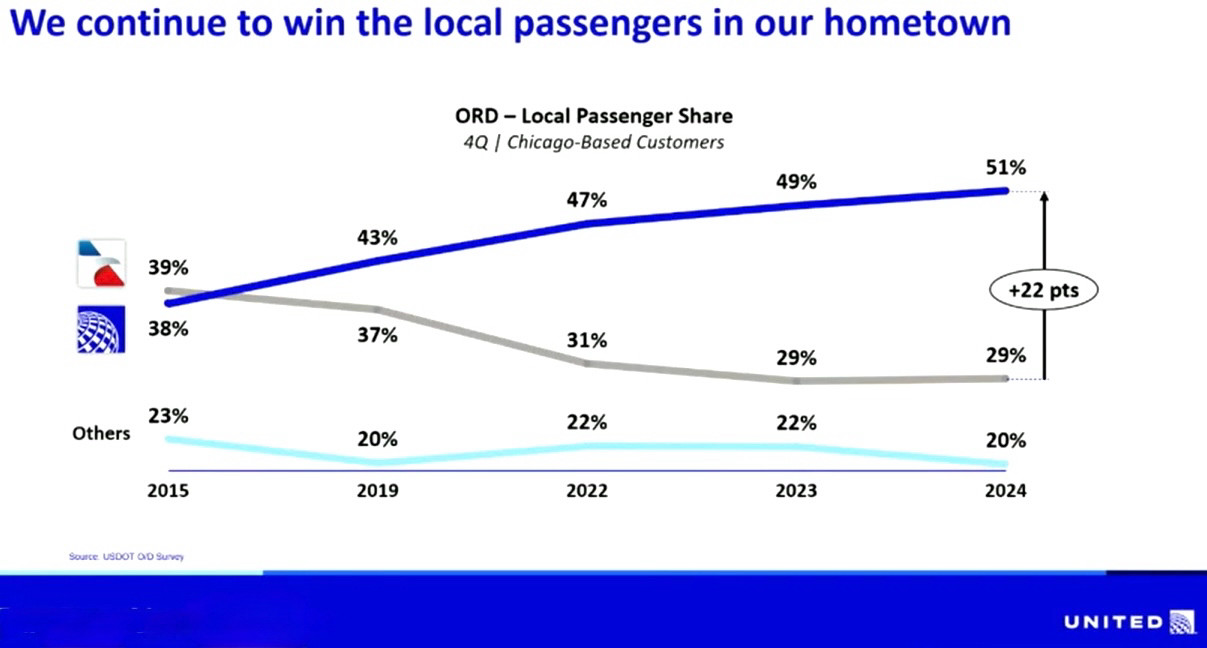
The difference has become stark. Anyone watching airline news won’t be surprised, since American has mostly ignored its Chicago hub for the last five years. It’s only just announced an expansion there, as the city plans to re-allocate gates away from American and to United which has been growing (American objects that their lease doesn’t actually allow this yet).
2015 is an interesting base year because it’s the last full year where United CEO Scott Kirby was the President of American Airlines.
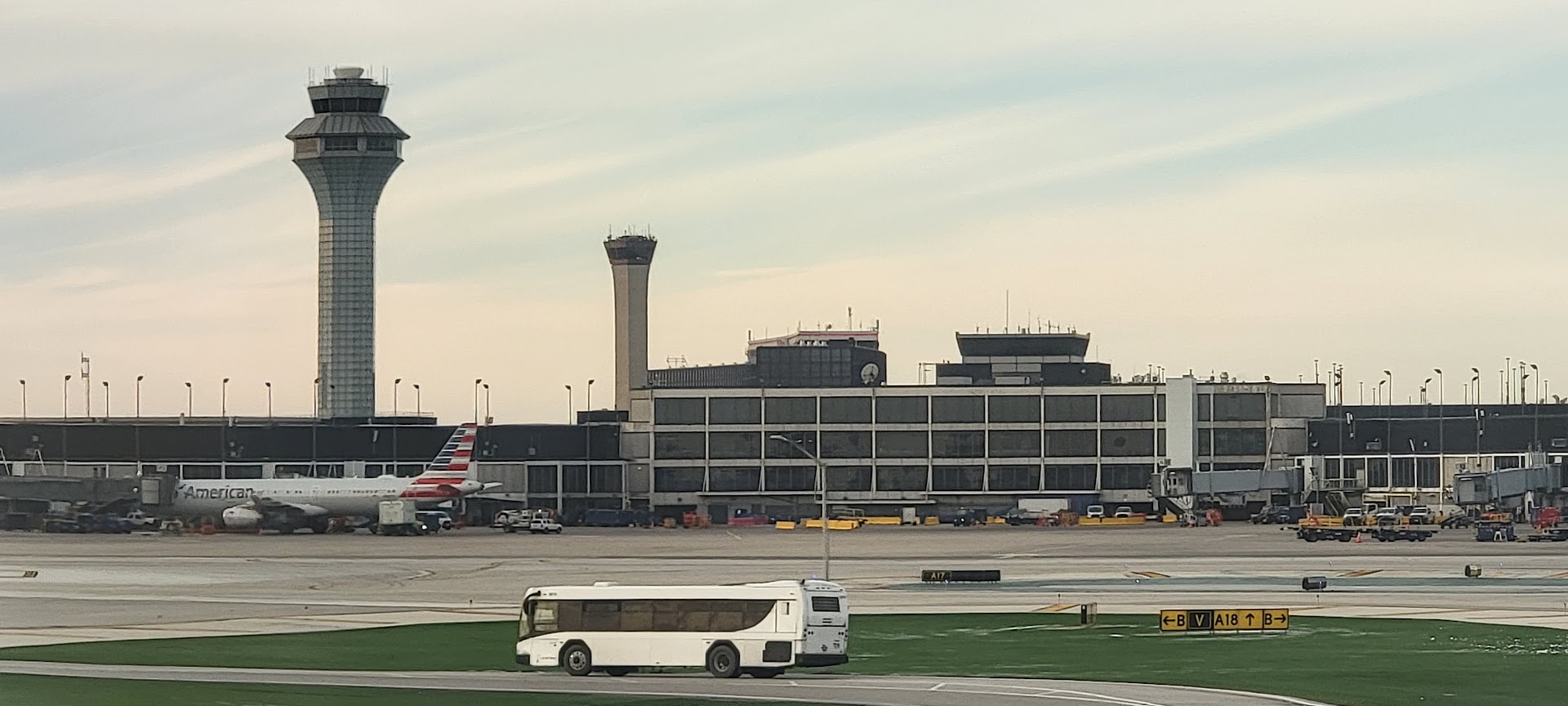
So what’s actually going on here?
Some of this is just a function of O’Hare flying.
- In the Smisek era, United was shrinking domestically. They flew a lot of smaller aircraft across their domestic network. Reversing this was an explicit strategy of Kirby’s – because he felt that size in a market would determine the airline’s share (and drive a disproportionate share of credit card acquisition).
I thought this might be important for comparison purposes but in fact United was larger in Chicago even a decade ago, and had grown while it was American that shrank in the years prior to the start of this analysis.
- According to data from aviation analytics company Cirium, the percentage of local traffic reported by United tracks fairly closely with the percentage of seats at O’Hare that each airline operates, within a few percentage points each year – although the gap here has been widening.
- Bear in mind that American built back O’Hare more slowly after the pandemic than United did. It also scaled back international flying from Chicago, and hasn’t had the large aircraft either – since it retired Airbus A330s and Boeing 767s during the pandemic and then Boeing delayed deliveries of the 787s it had on order.
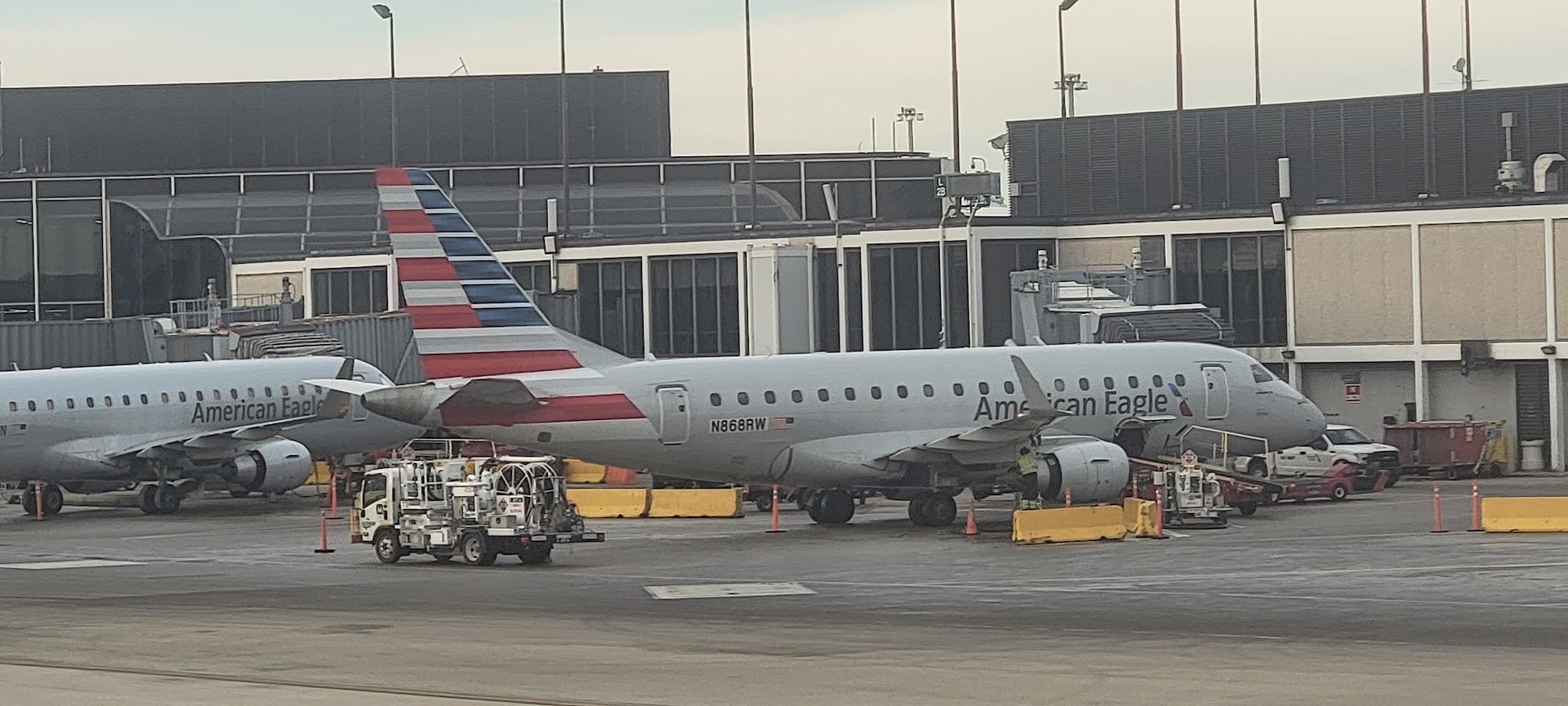
Some of this is a function of customers walking away from American.
- The percentage of American’s revenue from frequent flyers dropped markedly between 2016 and 2020, with the airline filling planes at low fares from infrequent flyers.
Before the pandemic started, 45% of American revenue came from 38% of customers flying more than once a year. However, four years earlier 50% of revenue came from just 13% of flyers. Getting even close to half of revenue required broadening the customer base in a short four years.
That followed a period of sharp devaluations in AAdvantage as well as product under US Airways management, and that management’s focus on competing mainly with Spirit and Frontier believing their model was the path to profitability (an odd position for a high cost carrier to take, and it did not work).
- And American now has a significant net promoter score deficit to United (and Delta).
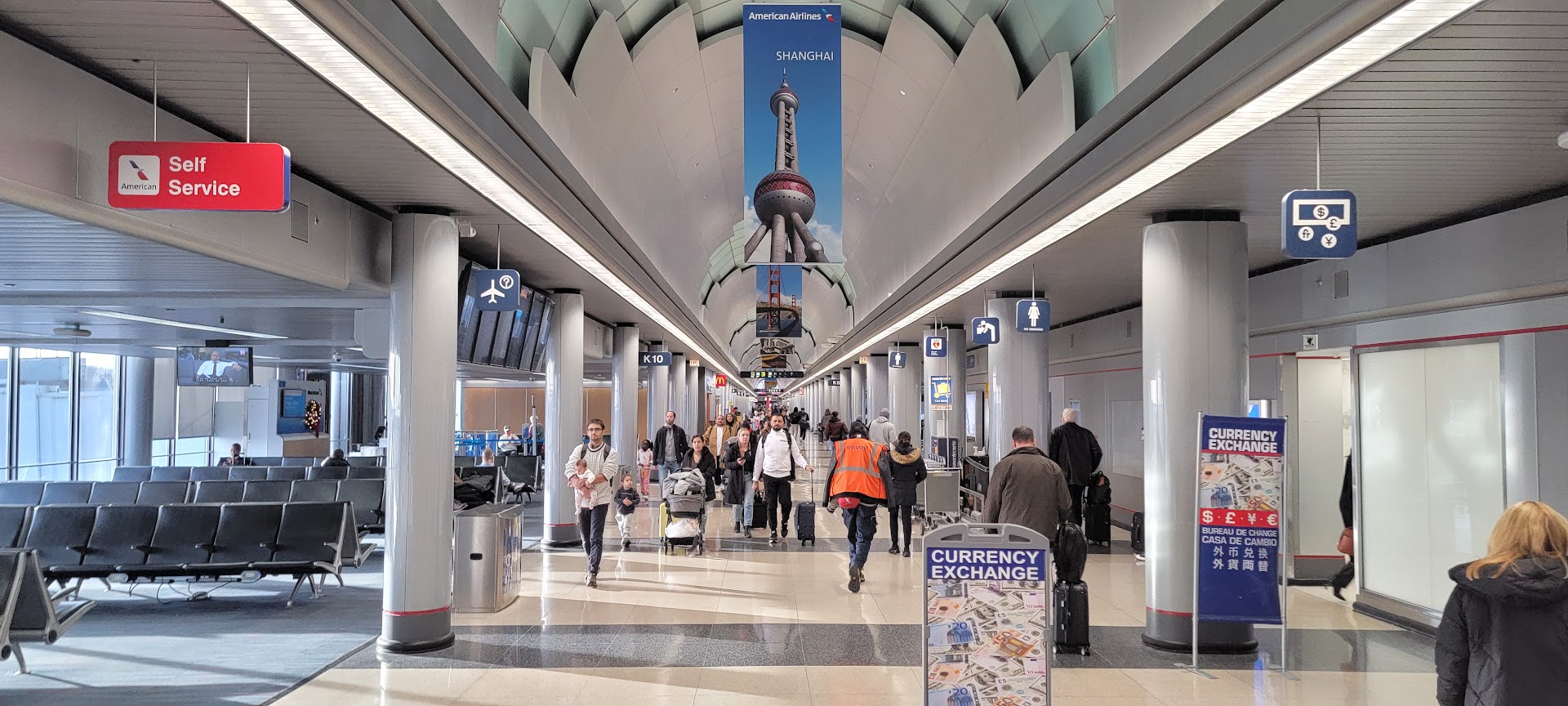
United has had better facilities in Chicago. Their size is supported by gate space. And that advantage is growing. In that sense, there’s a built-in advantage that’s growing provided they choose to continue flying heavily from the city.

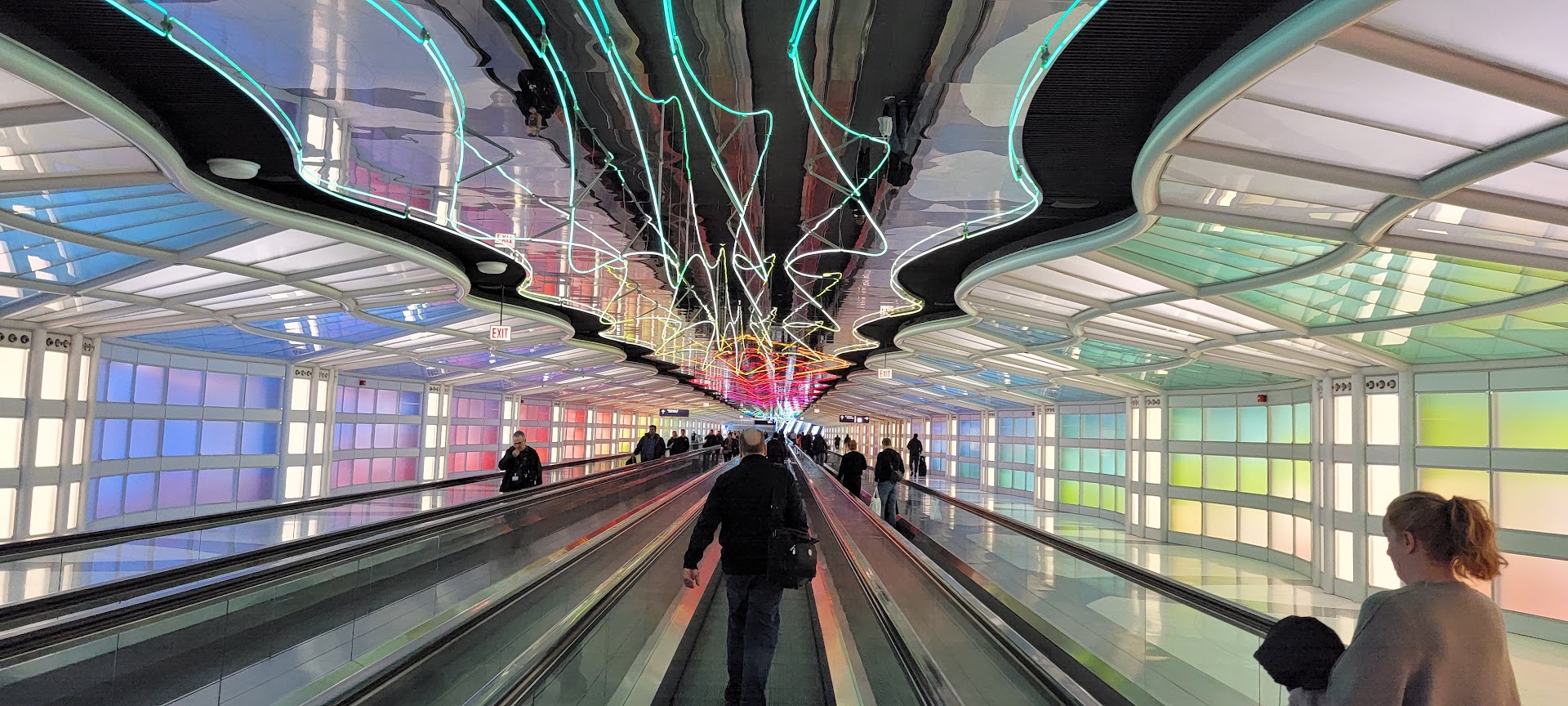
However, the number of seats per aircraft is directly under the control of each carrier. And the decline in customer preference for American is reversible under the right management strategy.
The idea that brand loyalty advantages are irreversible is silly. There was far less brand loyalty to United in 2015. They’re behind Delta in a decades-long effort to build this, just as they are still behind Delta in operational reliability and employee friendliness. American has a structural disadvantage in New York (because of a decision by prior US Airways management to walk away from LaGuardia), but if it made a concerted effort over time it could reverse its decline. And United is unlikely to match Delta’s service levels unless Delta declines.


American Airlines used to rule the roost at JFK and then surrendered the primary position as JetBlue and Delta gained ground. American cut back at JFK and just let Delta become the king of operations there despite American having a lot of advantages over Delta 20-25 years ago.
American Airlines also sort of gave up at ORD and now United is ahead of American Airlines at ORD.
American Airlines can’t seem to focus on a strategy, execute on it, and stick to it long enough not to become second or third fiddle when where it used to be first or co-first 20-25 years ago
Fascinating analysis, Gary. Thank you (and JonNYC) for compiling and sharing.
I wouldn’t use the word ‘toppled’ because that’s hyperbolic, but clearly, as Chicago is literally their headquarters, I would expect better for United at ORD. It is ironic that unlike ATL for Delta or DFW for American, ORD is relatively egalitarian, like JFK or LAX. Speaking of JKF, @GUWonder I’m not sure I agree with you about AA there (sure, T8 is fine, but T4 Delta, T5 jetBlue, and all the international carriers make it rather diverse and competitive.)
Generally, ORD still feels old (and disjointed). I’ve mostly been through there visiting Chicago or connecting domestically. On lounges, for UA, the United Club at C10 is fine (and often crowded), but the others are ‘meh.’ Since Polaris is currently closed, we’ll have to ‘wait and see’ whether the renovations will make it ‘worthwhile.’ Whereas, with AA, I actually prefer their Admirals Club at H/K; I haven’t tried the Flagship there yet, but at least they have a premium lounge that’s actually open!
On Delta, @Tim Dunn will be pleased that even though DL is just not that big of a player at ORD, they are trying. The move to T5 for them was a good idea, especially if connecting to international carriers. The new SkyClub there is excellent, too. (You can board the flights to LGA from the lounge!)
*JFK (oof)
I grew up in Chicago, started my road warrior career there 40+ years ago, and had a choice to focus on either AA or UA. As far as business travel, they were pretty much the same back then. I chose UA, and retired from active business travel a couple years ago, but fly leisure often. (I left Chicago in 1988 and have lived all over the US) Over the last 10 years, I was forced often by company rules to fly AA occasionally (for cost compliance) and despised doing so. For those that travel often, the difference between AA and UA for biz travel is dramatic. Nobody in their right mind would choose AA over UA for biz travel, unless you are one of those unfortunate souls that are based in DFW, CLT etc and you don’t really have a choice. I really feel sorry for those that flew most of their career on AA and now have nothing to show for it. ( I fly to Europe every couple months or so as I have kids that live there, and only fly Star Alliance carriers. Having lifetime *G status is a super valuable perk for me an my wife.) The stats at OHare are probably the best metric that sizes up the situation, if you have a choice at a hub, the dual AA/UA situation at ORD shows that travelers (especially biz) will choose UA over AA more than not.
AA never really recovered since the merger. They are still basically USAir, a second-rate airline that focuses on credit cards and leisure passengers. Pretty much on par with Spirit, maybe a step from Frontier, but at higher prices. The
I flew AA for the last time a couple months ago, used up the last of my banked AA miles. I was really happy on my last leg I flew, because I knew it would be the last time I would ever fly AA again.
AA decided to put it’s eggs in the CLT and DFWs basket. While the ORD concourses for AA look a bit dated they are very functional. I’d take ORD over CLT any day. I also think AA management got caught to much in the sunbelt strategy thinking ORD would become a bit of a dinosaur.
@GUWonder has a really good point re AA at JFK. Still can’t believe that AA spent so much building a new T8 on the grounds of what was T8 and T9, and had plans to expand it further, but didn’t exercise that option. At the same time, look at Delta and JetBlue expanding their terminals and giving themselves more gates. Obviously, gates aren’t the same as slots, but AA could have created a world-class OneWorld terminal at the most important airport in the US. Now you see OneWorld carriers (Cathay and quasi-OW AA-partner Aer Lingus) leaving T8 for T6 where they can build and operate their own world-class facilities.
Like Braniff, Eastern, Pan Am & TWA……American is quickly going out of business. It has simply become a gigantic combination of Frontier/Spirit Airlines. The employee morale is basement level, the service is basically non-existent, the airplanes filthy & broken. It’s only true assets are the AAdvantage mailing list, LHR slots & South America.
And Robert Isom will again find another excuse for its pathetic quarterly performance & lack of profit. This time blaming the tariff situation instead of taking responsibility for his utter lack of leadership.
American needs a new leader. Isom is not the guy, nor has he ever been the guy.
United needs to fix their boarding process, paid 1st class, board 50th and have no overhead bin space, I suspect United soon will address this, as giving your loyal flyers any benefit over a paying infrequent customer is fading away as the programs get better data.
@Nate, Terminal 8 was planned and ground broke in the late 1990s. 9/11 changed the calculus for the terminal’s full development. It was not built out to spec because AA, like the rest of the industry in the wake of 9/11, had to cut expenses deeply to survive. J
AA never “ruled” JFK. It was big, though and had the market to the Caribbean, and later to Latin America from there, and dominated the primary transcon markets. It started to build a significant TATL network out of JFK from 1987 with FRA, ZRH, and ORY, and then added LHR and MAN, from 1991 and ultimately also served BRU and for a short time, LYS. MAN was quickly axed in its first instance and then brought back. BHX came and went. Plans were developed to serve NCL and that never materialized. DUB was served for a time, and immediately post-merger, EDI was moved to JFK from PHL. There was also the BUD flight which was axed once MALEV failed. It was JetBlue that ate AA’s meal at JFK. AA had a high cost structure, refused to exploit Chapter 11 like everyone else, and then lost market share to DL and B6 as they both continued to expand JFK and improve their facilities there while AA remained stagnant.
American today is USAir, which was bad airline, and not a very profitable one. It chased leisure travel, and had some vanity routes to Europe and the Caribbean + Mexico and later Tel Aviv, but was layer cake (from so many mergers) of mediocrity through and through and sadly, that myopic vision lives on at American which has been pinching pennies proudly and loudly since it famously removed an olive from a salad in the Crandall days.
American in the 1980s and 1990s was the industry’s bell weather. It is today led incompetently and one does wonder why an activist hedge fund hasn’t taken it on yet.
@Coffee Please — *America. FTFY.
first,
let’s see how well UA’s margins compare to DL’s after UA settles with its 65,000 non-pilot unionized employees that are either working under amendable contracts or will by the summer.
FAs and mechanics can make or break any company and neither union is happy with UA’s progress.
There really isn’t any doubt that DL is the largest airline at LAX. Flying to HKG – which DL doesn’t or won’t do – doesn’t move the needle in a share gap that is several points wide between DL and UA. LAWA data shows AA and UA are at about the same share levels now.
and NYC is split between DL and UA. DL operates about 15% more flights from the 3 airports and is the largest domestic carrier while UA is the largest int’l carrier. There really are facts that are pretty public no matter how much UA wants to write its own definitions in order to argue how it wins.
it is also noteworthy how high UA’s share is in its largest hubs – despite some people repeatedly arguing that DL has monopolies in its 4 interior US hubs. UA’s revenue from its largest hubs and its share advantage is far larger than its hubs than DL gets from ATL, DTW, MSP and SLC.
DL gets far more revenue than UA in non-hub markets – and it is no surprise that UA talks so little about its non-hub share – because it is #4 out of the big 4 in that metric.
As for ORD, AA has been as back and forth about ORD as it has about NYC and PHL. No company can change its strategy every other year and expect to succeed.
I lived in Chicago for 18 years. Bounced between AA and UA as my local carrier, while remaining loyal to DL (even with connections I was generally a better experience). Over the 18 years I was in ORD I watched as AA slid and UA climbed. Today, there is no comparison.
AA can slashed and burned at ORD, invested little in the concourses and failed to keep up with their lounge experience (except for the Flagship Lunge, which is lovely). The concourses are dark and narrow. Hold gates lack adequate seating and convenience chargers. The G-concourse is just awful (only to be out-awfuled by E/F). UA’s piloting of clearing TSA without even whipping out an ID at T1 is beyond pleasant. And…horror of horrors…AA continued to operate CRJ-200s and E145s. That in and of itself is a disqualified when UA flies most routes AA flies, but with better aircraft.
AA is going to try to compete at ORD…and they will fail, unless they response to the core issues driving consumers away.
United’s analysis is fairly good but overstates its LAX presence. It could do better. United is also stupid to have left JFK. Very short sided. United should have JFK be a focus airport with service to LAX, SFO, and whatever it can get traffic to, which might be IAH and ORD.
@Jeff
“Nobody in their right mind would choose AA over UA for biz travel, ”
If they value high speed wifi, like many do in business travel, AA is the easy choice.
@Tim
United is bigger at LAX vs DL in the standard metric for airline size, ASMs. Delta was bigger in that metric, barely, in 2024 but Delta is behind United in capacity at LAX in 2025. Delta and United are both well behind domestic oneworld at LAX in every metric (AA’s strategy there), but by pure metal, delta has more flights and seats, but United is the biggest at LAX by ASMs in 2025.
Same story at the three NYC airports. In 2025, United leads across all three airports in ASMs, BY FAR. But in 2025, Delta is bigger in flights and seats (though United was ahead in seats in 2024, just not in 2025)
When will UA pay it’s people fair wages?
United may be better than AA in some ways, but it is still a race to the bottom. UA wifi is also terrible. All US airlines are pretty mediocre, with only DL rising a little above the pack. I don’t understand this UA chest thumping. Are they trying to impress investors? The reality is they are marginally better than terrible, which is not saying much.
Delta’s terminal(s) situation at JFK was junk in the early 2000s and even into 15 years ago while American Airlines investment in T8 had already made it nice. JetBlue’s terminal at JFK in the early 2000s was also weak. Delta was a smaller fish at JFK than AA and JetBlue back then.
JFK was American’s and American’s to be had — even more so after United pulled out entirely from JFK — but American Airlines screwed the pooch on that one. AA has sort of done the same thing at ORD as it cut back its long-haul international network out of ORD, thus handing United the lead international network player there.
@sign
Maybe if Sara Nelson worked for her own members instead of APFA, United FAs would have a deal. It was an awful strategy on her part and it backfired on her own AFA members.
Fire her. She’s the reason United FAs don’t have “fair wages”.
As a frequent flyer out of Chicago, I book travel and collect points on both AA and UA, as both have large networks and fairly reliable. I normally choose economy plus seating, PE or first class if available for a good price.
I choose based on schedule, equipment, and price. Sometimes AA comes out on top, sometimes UA. I find cross shopping the two gets me ahead in value over being loyal to one carrier.
We Chicago travelers are blessed that we have two carriers with large operations in one airport. Most don’t have that.
@GUWonder — Now you’re making me ‘jet-age’ nostalgic over here. Personally, I miss the old JFK T3, flying saucer. Once the Port Authority eventually finishes its renovations at T1 and T6 (2026-30?), they ought to just rename the four new mega-terminals complexes (T1, T2, T3, T4). Hilarious how Gary’s post about UA at ORD naturally evolved into discussion on NYC airports. Bah!
Watching AA deteriorate service (smaller planes, less frequency, pulling out) in all the places I fly regularly has been a decades-long disappointment. Many years of EXP were great, but I haven’t been in a decade since it just became too inconvenient and disappointing to try to be loyal. Overseas cut, prices hiked to the sky, reward flights slashed, unuseful upgrades, lounges restricted and quality lowered, reduction or abandonment of the West Coast except LAX, and NYC de-emphasized for international. Suddenly, EXP became just about impossible. So now I’m free.
I travel somewhat less for business than I did, but more internationally for vacations. And I’m enjoying seeing DFW only a few times a year instead of every couple of weeks. I miss ORD’s status as a way station for everywhere I need to go in the East, but I sure don’t miss the 737 downsize for every damned flight in or out of the west plus continued connections. It has freed me some to just consider schedule and comfort — which is really too bad (for AA).
As goes NYC so goes ……
AA has a tendency to shoot itself in the foot and then shoot itself in the other foot and who knows where else. AA wanting to route so much via LHR or PHL was just never going to fly well for me for one reason or another. AA’s draw down on international long-haul at JFK hit me, and then AA hit me again with a draw down of the same sort at ORD. The result is UA and Star Alliance got more flights from me than they would have 20-25 years ago. And then there are all the other problems that AA/Oneworld has — including with their hostility to thru-check bags across separately ticketed itineraries, which basically costs AA a nice chunk of our business from ORD since United (and even DL) are not as hostile to thru-checking across separately ticketed itineraries where the long-haul trip tickets originate at ORD.
max,
of course, UA wants to focus on ASMs – but it can’t turn its higher ASMs into higher revenue.
and scheduled capacity doesn’t matter.
UA flies about 7% more ASMs than DL and delivers less revenue.
and, yes, those statements include credit card revenue because it matters and is a part of UA’s business model and the refinery does not count which is why DL excludes it.
and, of course, UA has to pay its people decent wages. Alot of UA’s routes won’t work at the same margins if their people are paid the same as AA, DL and WN.
and, yes, AA and WN do carry the weight of higher wages.
and you still can’t grasp that AS’ revenue and capacity is not AA’s. AA and AS do not have a joint venture. oneworld capacity at LAX means nothing relative to DL or UA’s size.
UNITED rising
And you can see how the big shift started with Oscar Munoz, Gordon Bethune’s pick for the Continental board and who personally coached Oscar ahead of his first days at United.
Weird, tim
United just beat delta on margin
But keep crowing about whatever new financial metric you’ve come up with
And, if you’re a customer in lax and your status is rewarded on AA or AS, yes it does matter.
It’s why the two oneworld domestic carriers do what they do on the west coast. For credit cards and for utility at lax, yes it does matter that oneworld is by far the biggest at lax and across Southern California.
If they didn’t recognize each other’s status and made no attempt to be useful between AA and AS; perhaps I’d agree but they do.
It gets super old hearing you whine about your specific delta metric
United is bigger by capacity at lax for metal. Oneworld is the biggest domestic alliance at lax.
It does matter because customers aren’t penalized flying between AA and as
You need new talking points
I don’t care who is king @ ORD United overcharges like Delta and would let
a seat go empty most of the time than discount it
Same goes for award travel
And partner awards laughable when other Star Alliance partners charge less for United flights on points/miles.Almost never United sorry!
Which brings me to think Of Delta 100% more for tickets on average and horribly crowded with long lines of cattle.Eeek Atlanta
Another always avoid.Delta is also the cancer that destroyed FF programs
Hate them for ruining airline loyalty programs.
Should I tell you what I really think? 😉 🙂
I’ve been ORD based since graduating college and still find AA to be a better experience. I think in the last 15y of flying I don’t think I’ve waited more than 5m to get thru the PRE- Check line in T3. The lounges aren’t ground breaking…..but the H/K is rarely close to capacity and recent food enhancements are a step up. AA has pretty close to the same schedule domestically as UA….at least to the 10 places I usually fly. Where they do suck is connecting internationally…..I don’t want to connect if I don’t have too….and def don’t want to connect in LHR.
Where AA really has let me down so to speak was the Int’l expansion they started pre-covid. They added some attractive non stops like Prague, Dubrovnik, and Budapest. Ive taken the Venice route, but that has been abandoned in favor of testing Naples. AA retiring planes during Covid is one of the biggest blunders in recent times. I understand why they did it, but it was wrong. Similarly cutting 8 J seats in the 787-8s. Ironically they are about to get planes with 60 premium seats heading into a down turning market.
One thing I will say about AA at ORD….it’s probably the best hub for a top tier elite member. We’ve had great upgrade success as an EXP with around 275k rolling LPs. Upgrade percentage is roughly 50% and then buy up the rest. We’ve also gotten great value out of miles. Coach awards we continually get close to $0.025 to $0.03 per mile. We’ve also booked several last minute ORD-Europe for 62k miles.
AA is not perfect at ORD, but anyone with understanding of how to work the system i think will extract outsized value from Aadvantage compared to Mileage Plus
max,
and UA has or will have amendable labor contracts with nearly all of its non-pilot labor groups. There isn’t a UA flight attendant or mechanic or gate agent that gives one rip about UA’s margins as long as they are underpaid.
And considering more of UA’s employees live in high cost locations than AA, DL or WN employees, the cost of living adjusted wages for UA employees is far lower than any of the other big 4.
The only one that needs ACCURATE talking points is YOU.
The discussion is about size and capacity, not alliance benefits.
AS’ capacity means nothing in calculating AA’s size in LAX or the west coast.
and dw,
of course UA charges high fares comparable to DL. They simply do so in hubs that are larger markets than DL’s big 4 hubs. Unlike AA, DL or WN, UA carries pretty small percentages of domestic connecting traffic.
UA’s monopolistic pricing is more effective in raising UA’s margins than DL because UA’s hubs are in larger markets. Anyone that remotely understands the US airline industry knows that UA gets a higher percentage of its revenue in its hubs than AA or DL.
Without a doubt, I too find AA’s loyalty program points are better for award ticket pricing/availability on AA metal into/out of ORD than UA’s loyalty program points are for award ticket pricing/availability on UA metal into/out of ORD.
Shaun is right about AA also being better for upgrades for EXPs originating at ORD than UA is for 1ks originating at ORD. [Not that it does me any good — as my personal comp “domestic” upgrade chances border on nil due to my booking/travel pattern.]
I’m shocked that United has the chutzpah to compare itself to the world’s only PERFECT airline. LOL
I’m thoroughly enjoying this back-and-forth between @Tim Dunn and @MaxPower. Wherever these so-called ‘talking points’ are originating from, they’re excellent. Keep it going, fellas!
@GUWonder — Yes, on AA point redemptions, there is indeed still outsized value. Recently used 41K/person for JFK-SFO, and 43K/person LAX-JFK, each in Flagship First. Cash price was $5K/way. That was an insane 10x value. The only issue is no current transfer partners. Was nice while it lasted with BILT, but that’s no-more. Maybe Citi will bring it back, or not. Who knows… Much better than SkyPesos. United still has some decent value, and thankfully has Chase/BILT for transfers.
Unfortunately, on AA at LAX, First Dining is STILL closed, and the regular Flagship is fine, but it’s the old style. At least JFK has the relatively new Chelsea lounge for Flagship First (which is at least as good as, perhaps even better than, DeltaOne and Polaris at most locations).
If it weren’t for the AA points providing me more outsize value than UA’s points, my use for AA at ORD would drop even further and it would have played to UA’s advantage.
Speaking of outsize value, I’m looking at redeeming 15k miles for a one-way economy class trip next month from the US to Australia. If I go for that outsize value, it will set my record for most uncomfortable miles flown per mile redeemed. 😀
@GUWonder — That’s insane! Is it on AA metal, or a codeshare like QF or Fiji? Even in Economy, US-Oceania should be like 50-100K for them to breakeven; I’d have to imagine in normal times the cash price is $500-1,000/person/way. Well done!
I’m an ORD based flyer. Would never event consider United. They are trash from the word go. Their facilities are not nicer, unless you like walking 20 minutes to get to a gate. There lounges are dumps. And their boarding process is despicable.
“It is not the critic who counts; not the man who points out how the strong man stumbles, or where the doer of deeds could have done them better. The credit belongs to the man who is actually in the arena, whose face is marred by dust and sweat and blood; who strives valiantly; who errs, who comes short again and again, because there is no effort without error and shortcoming; but who does actually strive to do the deeds; who knows great enthusiasms, the great devotions; who spends himself in a worthy cause; who at the best knows in the end the triumph of high achievement, and who at the worst, if he fails, at least fails while daring greatly, so that his place shall never be with those cold and timid souls who neither know victory nor defeat.” ― Theodore Roosevelt
But to be clear
Props to United
They have a laser focus on being better
Every delta fan wishes Ed Bastian wasn’t the ceo.
He inherited greatness
He’ll leave mediocrity
@MaxPower — No way. As a passenger and frequent flyer, it’s Delta over United, any day.
To quote from HBO’s Chernobyl: “Take him to the infirmary. He’s delusional!”
max,
we realize you live in a world of delusion but DL is still the US’ most profitable airline (one quarter doesn’t change anything), carries more domestic ASMs on its own metal than any other US airline, and has the best operational and customer service metrics.
just as an example, UA’s baggage mishandling rate was 9th worse out of 10 airlines… only better than AA.
DL was the best of the 4 legacy/network carriers – yes better than AS.
UA had the worst cancellation rate of the 4 legacy/network carriers – worse than AA.
As usual, you project onto DL the deficiencies of AA or UA.
It is UA that demonstrates mediocrity – but since you are emotionally incapable of recognizing that DL does something better, it is no surprise that you manipulate reality.
I used to live in major United hubs (SFO, then IAD). Now I live in Seattle. United is even smaller there than they were when I moved here ini 2019, with only three or four gates in the A terminal – it is almost as little as at SMF. Alaska and to a smaller extent Delta dominate here. I wish United would assert itself more at SEA.
The down fall of American Airlines all started with Parker (Former CEO). Parker was the worst CEO and should have been fired and never ,have been able to destroy a once a great airline.
I think an unrecognized reason United is leading AA in Chicago ( at least for me) is that they have a transfer relationship with the Chase Reserve and Preferred cards. I have status with AA and was a loyal flyer for years but I accrue lots of miles on UA via the Chase cards and use them frequently on United international flights. AA does not have card partners with anyone like Chase , they have limited international flights and partners and they have now lost me ( not to mention the fact that AA , on Christmas Eve, cancelled my May direct flight to CDG from ORD and now only offers that flight via Philly).
what has also not been mentioned in this conversation is that ORD is already the most expensive airport in the middle of the country for airlines to connect passengers and it will only get more expensive as ORD builds the new grand terminal. DTW and MSP cost DL 1/3 of what AA and UA pays to handle passengers. DFW is also about 1/3 of ORD’s rates – which is why AA really does not need a massive hub operation… they just need enough gates to be able to serve the local market. AA at CLT and DL at ATL are about 1/8 the cost to operate; the former offers one of the worst experiences for a large hub while ATL works outside of major weather events.
UA has no large middle of the country hub that is anywhere near the size of ATL or DFW or CLT.
“winning” ORD for UA will simply mean they get saddled with a larger portion of the bill for the new terminal.
carleton,
as much as some people fail to understand, much of the share that DL gained when it built its SEA hub came from UA and WN.
UA isn’t going to rebuild SEA.
and john
remember that parker gained control during the tAAkeover by US by convincing AA employees that he was in their best interest. He then proceeded to do one stock buyback after another all way replacing AA’s fleet which had grown very old. Problem is that AA’s fleet is not any more new generation than DL or UA’s because AA bought so many 737-800s and A321CEOs.
and lots of people are probably not aware that UA is also doing stock buybacks. check out the earnings transcript in which analysts note that DL is not buying back stock until it gets its debt paid down while UA bought back large amounts of stock during the 1st quarter – even as airline stocks fell like rocks.
as much as people want to think Kirby is a totally new person than he was at AA, he is doing some of the very same things including growing off the backs of employees who are underpaid relative to the competition.
“Leaked slide”?
Oh, please. Enough with the eyeballs on screens drama.
This isn’t the CIA.
West Coast flyer however ORD is my 2nd “home base”. What Parker & Co. did to ORD is rather despicable. They completely gave up on one of the pre-eminent cities in the United States and have basically handed it over to their competitor. Isom is no better -at all.
AA has no “direction” anymore. They are no longer considered a top carrier and they’ve gotten beaten around the bush in some of the top cities in the United States (Chicago, New York, San Francisco, etc.). Focusing on CLT, PHX, etc. has barely helped. Their “saving grace” is that Texas/Dallas is growing and they do well there. I don’t see PHX nor CLT really replacing ORD, JFK/LGA, etc. anytime soon.
Many years ago (at the time of the AA/US merger), I blogged a few times about how unions were going to shoot themselves in the foot aligning themselves with Parker…well, here we are.
I’m still loyal an AA/OneWorld flyer however once I hit the 2 million mile mark on AA (at 1.6 million miles), I might start flying other carriers.
Late to the game on this one. I have had ExecPlat for longer than I can remember, and was CK for a number of years (earned) — so yes, I’ve been the loyal AA flier. But I have had to conclude it is just an incompetently run airline. When Mr. Parker left the CEO slot — he’s a great financial architect, can’t run an airline — I was hoping for a change but things have gone from bad to worse.
United — and Flying Blue (which, sadly involves Delta) are both better run options, with the downside being United means flying Lufthansa to Europe in some cases.